Hydration and Exercise Performance. Does it Really Matter?
So I was fired up from my NSCA conference experience. In my mind, we had two opposing observations about hydration and how it affected physiology and performance. When we did hydration studies in laboratories and climate chambers, we seemed to get a very different response to what we were seeing in

So I was fired up from my NSCA conference experience. In my mind, we had two opposing observations about hydration and how it affected physiology and performance. When we did hydration studies in laboratories and climate chambers, we seemed to get a very different response to what we were seeing in field conditions. Those lab-based observations were supporting the hydration industry, and the hydration industry was doing all it could to make sure the world knew about it.
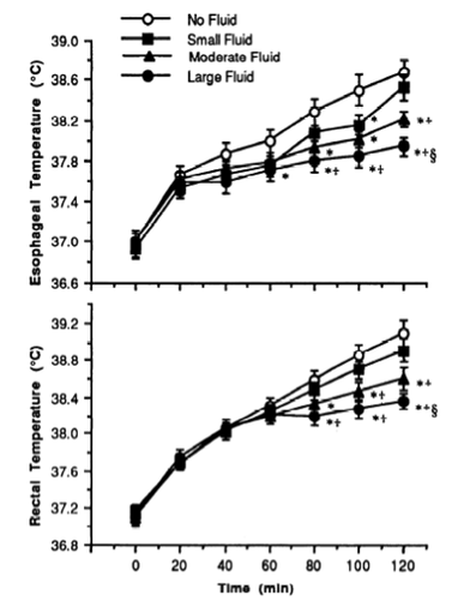
Perhaps we should begin by having a look at the hydration argument from the drink to maintain body mass to 2% side. We’ll go back to a key study that convinced most of us of that in 1992 by Scott Montain and Edward Coyle. In this study, the authors took 8 highly trained cyclists and had them cycle for 2 h at 62-67% VO2max in hot conditions (33 degrees Celsius, 50% humidity, and facing a slow fan speed of 8.6 km/h). On different occasions, the cyclists randomly received no fluid (NF), a small amount of fluid (SF; 0.6L), a moderate amount of fluid (MF; 1.4L), or a large amount of fluid (LF; 2.4L) that replaced nothing, 20, 48, or 81% of their sweat losses, respectively. [pause for a moment and image how you’d feel consuming fluid in the LF condition…]
The authors showed linear relationships between those hydration levels and the core temperature increase (right), heart rate rise, and stroke volume/cardiac output decline (below). All the evidence supported the idea that drinking to maintain body mass prevented your temperature from increasing, and how much blood that your heart delivered to the rest of your body.
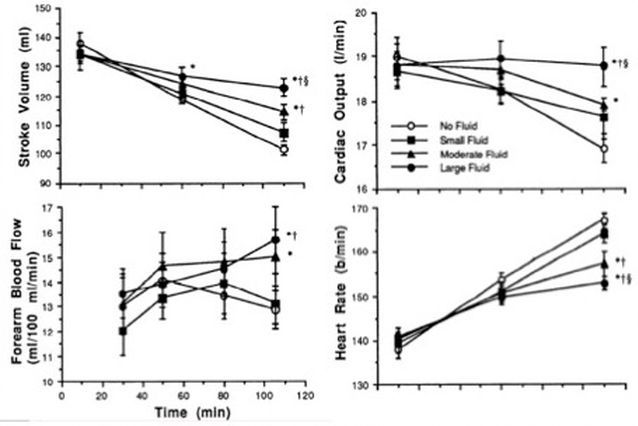
So back in ’92, this was pretty convincing data to support the concept that you should drink a moderate to large amount of fluid during exercise in the heat to avoid fatigue, maintain health, function best, and maximise performance.
But how then can we have situations like I came across in the field, where athletes were dehydrating by up to 4%, heart rate was stable, core temperature was stable, and performance was pretty darn good? Why didn’t my field study results mentioned in my first post line up with these laboratory data?
Maybe a couple of reasons, we thought. First, in every hydration study to that point, the subject/athlete would come into the lab, and they would know exactly which condition they were performing. When you get handed a drink (or not), you know whether you’re getting a big drink, a little drink, or nothing at all. That matters less for the physiologic data, but most certainly has an influence on performance; because word on the street was (and probably still is) that hydration affects your performance. Pygmalion effect – what you believe, will happen.
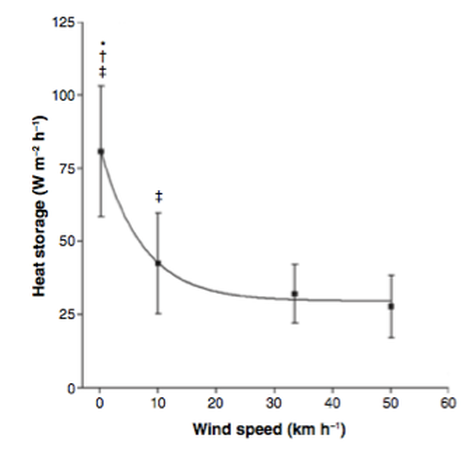
Second, while the heat and humidity in field and lab-based studies might be similar, the airflow around the athlete (wind; termed convective cooling) in most studies to that time, was clearly not. Airflow was often relatively still in the climate chamber, and typically high in the field setting. This has a profound effect on your heat load/storage, as shown nicely by Saunders et al. (2005). In this study (left), they replicated some of the Montain & Coyle (1992) conditions, except they altered the wind speed in their 2 h trials. Results showed that the wind speed affected how much heat was stored, and subsequently most of the parameters mentioned in the Montain and Coyle (1992) study (i.e., made them not matter – heat was being offloaded effectively so no issues with temperature or cardiovascular physiology).
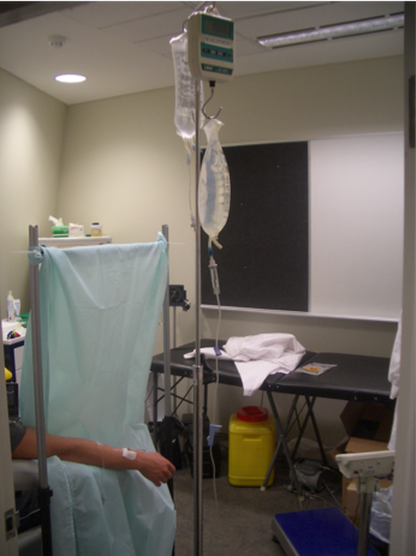
How did we start?
Clearly, we somehow needed to address the two main problems with lab-based research interpretation in the field setting. These again we felt were more realistic airspeed on the subject, and hydration blinding. The first was easy. We took a big fan (below) and drove airflow around the cyclist at a speed near typical of outdoor riding (32 km/h), just like in the Saunders study. The second issue, blinding hydration manipulation to a participant, was a bit more complicated. Luckily for us, Greig had experience from Larry’s lab, where they had done this using intravenous saline infusion. With this, if we kept the saline bags out of sight (left), the subject had no idea whether or not they were receiving no fluid, a little fluid, or lots of fluid back into their circulation.
So with those two main differences in mind, I was fortunate to team up with my post-doctoral researcher at the time, Greig Watson. Greig is UK born, but was coming straight to me in Perth from doing his PhD in Lawrence Armstrong’s lab in the US. Now the interesting thing about Greig coming from Armstrong’s lab, was that Dr Armstrong is listed as a key author on all of the ACSM hydration position stands. So Greig would naturally be arriving in my lab with similar views. But it was clear during Greig’s interview that he could see other side of the coin, and we both agreed that there was a need for some innovative research in the area.
How it came off
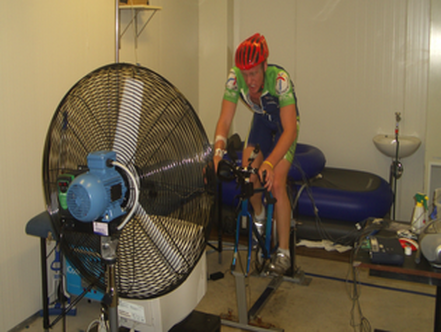
Brad Wall was the Masters’ student that would run the study. To test the effect of different hydration levels in relatively ecologically-valid (i.e., real world) conditions, we had subjects dehydrate by intermittently walking on a treadmill and cycling easy in the heat for 2 hours until they lost 3% of their body mass (figure below). We then rehydrated them with saline to the levels that we felt mattered within the current debate. The ACSM position statement said 2% mattered, so lets test 2%, and beyond that level at 3%, and compare with euhydration (0%; fully hydrated). We thought that 2% wouldn’t matter, but that 3% would (i.e., we’d see evidence for many of the effects shown by Montain and Coyle and others and emphasised in the position statements).
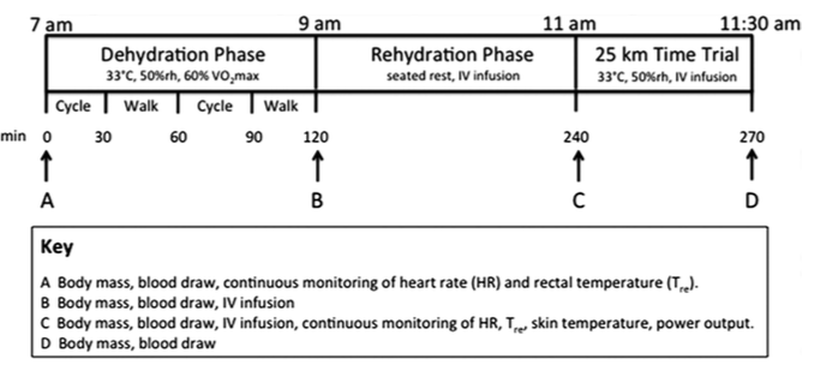
What happened?
The study was nicely run by Greig and Brad. Tight control and look how clean the body mass data was (Table 1). We were amazed at the time, because we too thought that 3% would matter, but besides core temperature being marginally (0.3C) higher, nothing really was different at all. Performance was the same – identical. Nor could subjects even tell what condition they were under. With the exception of the slight rise in temperature with 3% dehydration (water has a high specific heat; more water means more heat absorption), the amount of fluid on board made hardly any difference to physiology or performance. The complete article was just made open access and can be downloaded here. Check it out.
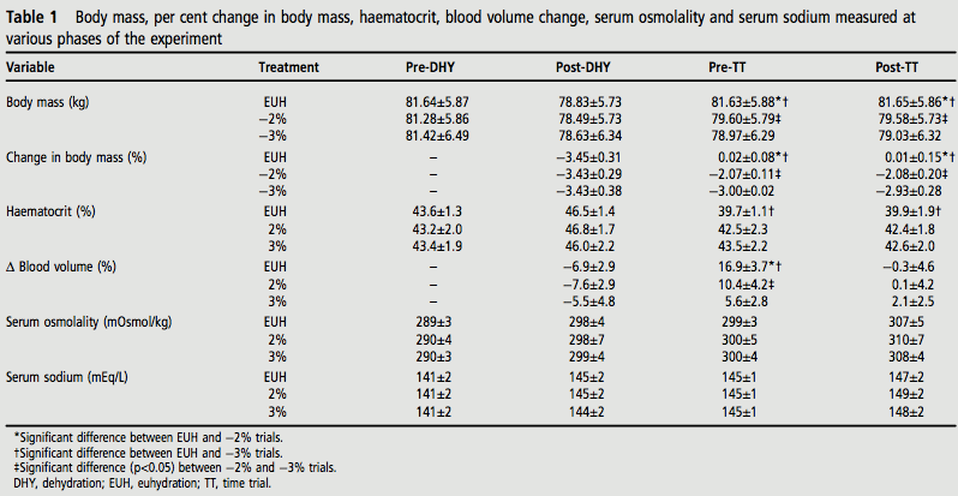
Why Did we Find the Results we Did?
The discussion section in our paper expands on these points, but basically we think it came down to three main factors, and these help explain the disparity between the bulk of lab-based work and real world observations. These were:
- removal of sensory cues related to hydration status – subjects had no idea what condition they were under, so their brains couldn’t sabotage the experiment through any belief effect, Repeated in Stephen’s experiment too remember.
- higher convective and evaporative cooling rates used – as mentioned and shown, skin and core temperatures (figure above) were for the most part the same between conditions. When the body is able to off-load its metabolic heat production, hydration status doesn’t matter. If it can’t offload its heat, such as with high humidity conditions, or maybe when moving speed slows (cycling up a hill, running), then it might start to make more of a difference. But not too much (see Saunders figure above).
- the restoration of blood volume during the rehydration phase – this was a pretty neat finding for us, even though it was discovered long ago. It gets to the nitty gritty, but if you follow some of the detail in Table 1, it shows how the vascular compartment (where the blood moves; arteries, veins, etc) resisted depletion of it’s volume irrespective of how much water was in the body. So cool, and how it should be, but basically, when there was less water on board in the body, the hormones and the kidney’s kicked into action to adjust blood volume to just the right amount needed function optimally, despite a total body water deficit of up to 3%. Physiology is cool eh?
Conclusion
So what can we conclude from all this? For me, as a practitioner advising coaches and athletes on how to maximize performance, I think the most logical thing you can take from all of this, is that hydration really isn’t that important beyond basic common sense. Hydration status, at least to 3% body mass loss, which is a fair amount, really doesn’t matter much to performance. The latest review article on the topic, lead by Jim Cotter and is open access, puts the issue to bed in my view.
While ours is only one study, it was especially pleasing to see my colleague Stephen Cheung confirm the finding for us in a recent study, written nicely in lay terms by Alex Hutchinson. Stephen mostly replicated our design, but added one additional piece by having subjects’ mouth rinse to alleviate some thirst. Again, performance was the same across the board. Nothing from the hydration status standpoint mattered for performance.
And just to be clear, I’m most certainly not saying here not to drink when you train or perform. All I’m saying is that we probably shouldn’t spend too much time worrying about this item. Common sense prevails – have fluids available and consume according to thirst. If you want an action strategy around your fluids that helps, try to have those fluids be ice cold to enhance performance in the heat. You’re brain’s inbuilt mechanisms relating to thirst will guide fluid volume to what it needs.
Take home message as covered nicely by the CBC in Canada.
Plews and Prof key messages
- In this study, when cyclist’s were unaware of their dehydration level, performance and physiology were unaffected to 3% dehydration.
- For training and racing in the heat, current best practice advice is to simply ensure that cold fluids are available.
- Then, if you are thirsty, drink. Everything else is just marketing.


Comments ()